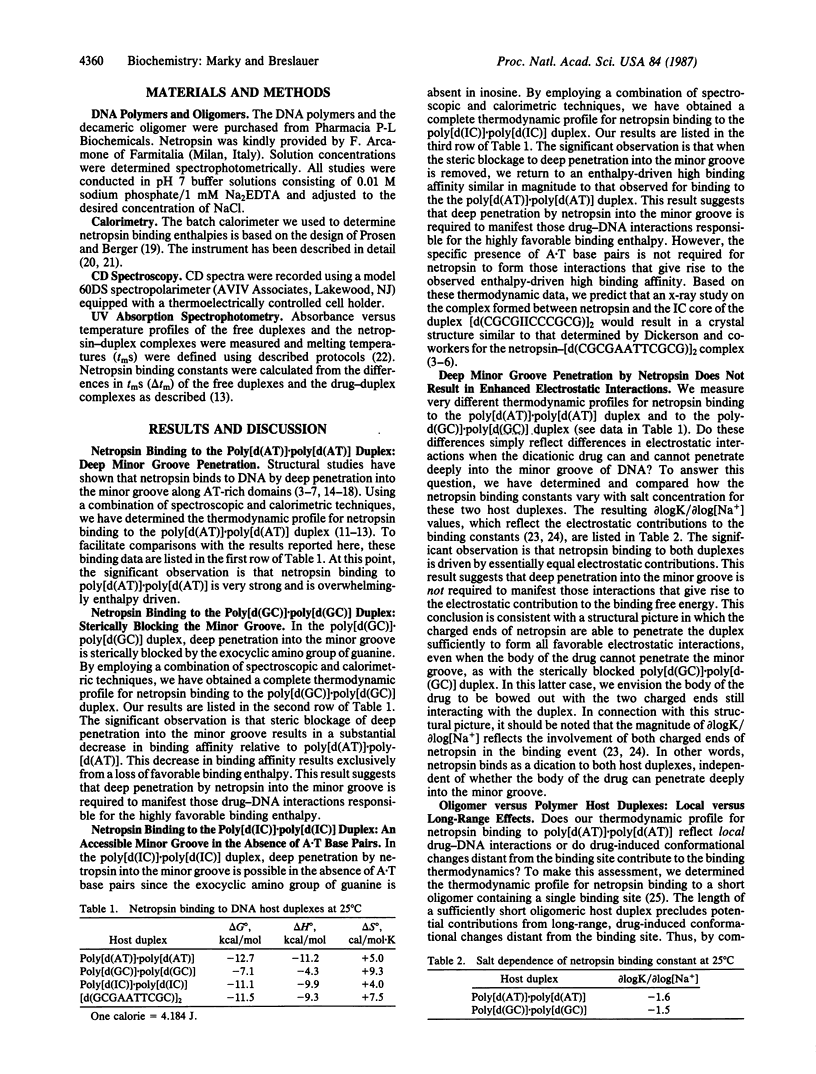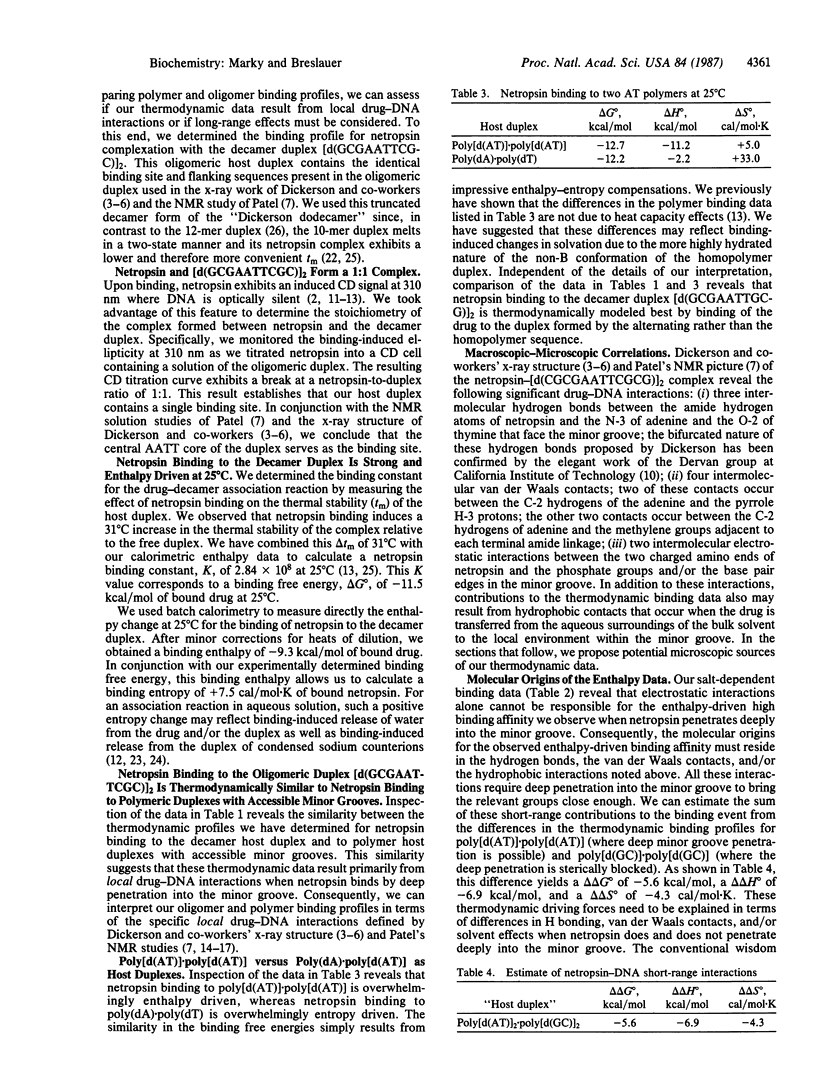Abstract
We report complete thermodynamic profiles for netropsin binding to an oligomeric and to several polymeric DNA host duplexes. These data allow us to reach the following conclusions: netropsin binding by deep penetration into the minor groove is overwhelmingly enthalpy driven and exhibits a very high binding affinity (K approximately 10(9) at 25 degrees C); deep penetration into the minor groove is required to form those drug-DNA interactions responsible for the enthalpy-driven high binding affinity of netropsin; I-C base pairs form binding sites for netropsin that thermodynamically are equivalent to those formed by A-T base pairs; the positive binding entropies reflect entropic contributions from molecular events other than just water spine disruption; the thermodynamic binding data primarily reflect local netropsin-DNA interactions rather than long-range binding-induced conformational changes at regions distant from the binding site; the enhanced binding affinity associated with deep penetration of netropsin into the minor groove does not result from more favorable electrostatic interactions; the binding of netropsin to the central AATT core of the decamer duplex [d(GCGAATTCGC)]2 is thermodynamically modeled best by netropsin binding to the poly[d(AT)].poly[d(AT)] duplex rather than the poly(dA).poly(dT) duplex. We propose correlations between our thermodynamic data and specific molecular interactions defined by NMR and x-ray structural studies on similar and identical drug-DNA complexes.
Full text
PDF




Selected References
These references are in PubMed. This may not be the complete list of references from this article.
- Breslauer K. J., Charko G., Hrabar D., Oken C. Base stacking in the dinucleoside phosphate rapa. Biophys Chem. 1978 Sep;8(4):393–397. doi: 10.1016/0301-4622(78)80021-0. [DOI] [PubMed] [Google Scholar]
- Breslauer K. J., Frank R., Blöcker H., Marky L. A. Predicting DNA duplex stability from the base sequence. Proc Natl Acad Sci U S A. 1986 Jun;83(11):3746–3750. doi: 10.1073/pnas.83.11.3746. [DOI] [PMC free article] [PubMed] [Google Scholar]
- Dervan P. B. Design of sequence-specific DNA-binding molecules. Science. 1986 Apr 25;232(4749):464–471. doi: 10.1126/science.2421408. [DOI] [PubMed] [Google Scholar]
- Dickerson R. E., Kopka M. L. Nuclear Overhauser data and stereochemical considerations suggest that netropsin binds symmetrically within the minor groove of poly(dA).poly(dT), forming hydrogen bonds with both strands of the double helix. J Biomol Struct Dyn. 1985 Dec;3(3):423–431. doi: 10.1080/07391102.1985.10508431. [DOI] [PubMed] [Google Scholar]
- Freier S. M., Sugimoto N., Sinclair A., Alkema D., Neilson T., Kierzek R., Caruthers M. H., Turner D. H. Stability of XGCGCp, GCGCYp, and XGCGCYp helixes: an empirical estimate of the energetics of hydrogen bonds in nucleic acids. Biochemistry. 1986 Jun 3;25(11):3214–3219. doi: 10.1021/bi00359a020. [DOI] [PubMed] [Google Scholar]
- Goodsell D., Dickerson R. E. Isohelical analysis of DNA groove-binding drugs. J Med Chem. 1986 May;29(5):727–733. doi: 10.1021/jm00155a023. [DOI] [PubMed] [Google Scholar]
- Harshman K. D., Dervan P. B. Molecular recognition of B-DNA by Hoechst 33258. Nucleic Acids Res. 1985 Jul 11;13(13):4825–4835. doi: 10.1093/nar/13.13.4825. [DOI] [PMC free article] [PubMed] [Google Scholar]
- Kopka M. L., Fratini A. V., Drew H. R., Dickerson R. E. Ordered water structure around a B-DNA dodecamer. A quantitative study. J Mol Biol. 1983 Jan 5;163(1):129–146. doi: 10.1016/0022-2836(83)90033-5. [DOI] [PubMed] [Google Scholar]
- Kopka M. L., Yoon C., Goodsell D., Pjura P., Dickerson R. E. Binding of an antitumor drug to DNA, Netropsin and C-G-C-G-A-A-T-T-BrC-G-C-G. J Mol Biol. 1985 Jun 25;183(4):553–563. doi: 10.1016/0022-2836(85)90171-8. [DOI] [PubMed] [Google Scholar]
- Kopka M. L., Yoon C., Goodsell D., Pjura P., Dickerson R. E. The molecular origin of DNA-drug specificity in netropsin and distamycin. Proc Natl Acad Sci U S A. 1985 Mar;82(5):1376–1380. doi: 10.1073/pnas.82.5.1376. [DOI] [PMC free article] [PubMed] [Google Scholar]
- Manning G. S. The molecular theory of polyelectrolyte solutions with applications to the electrostatic properties of polynucleotides. Q Rev Biophys. 1978 May;11(2):179–246. doi: 10.1017/s0033583500002031. [DOI] [PubMed] [Google Scholar]
- Marky L. A., Blumenfeld K. S., Breslauer K. J. Calorimetric and spectroscopic investigation of drug-DNA interactions. I. The binding of netropsin to poly d(AT). Nucleic Acids Res. 1983 May 11;11(9):2857–2870. doi: 10.1093/nar/11.9.2857. [DOI] [PMC free article] [PubMed] [Google Scholar]
- Marky L. A., Blumenfeld K. S., Kozlowski S., Breslauer K. J. Salt-dependent conformational transitions in the self-complementary deoxydodecanucleotide d(CGCAATTCGCG): evidence for hairpin formation. Biopolymers. 1983 Apr;22(4):1247–1257. doi: 10.1002/bip.360220416. [DOI] [PubMed] [Google Scholar]
- Marky L. A., Snyder J. G., Remeta D. P., Breslauer K. J. Thermodynamics of drug-DNA interactions. J Biomol Struct Dyn. 1983 Oct;1(2):487–507. doi: 10.1080/07391102.1983.10507457. [DOI] [PubMed] [Google Scholar]
- Mudd C., Berger R. L., Hopkins H. P., Friauf W. S., Gibson C. An optimized differential heat conduction solution microcalorimeter for thermal kinetic measurements. J Biochem Biophys Methods. 1982 Aug;6(3):179–203. doi: 10.1016/0165-022x(82)90042-2. [DOI] [PubMed] [Google Scholar]
- Patel D. J. Antibiotic-DNA interactions: intermolecular nuclear Overhauser effects in the netropsin-d(C-G-C-G-A-A-T-T-C-G-C-G) complex in solution. Proc Natl Acad Sci U S A. 1982 Nov;79(21):6424–6428. doi: 10.1073/pnas.79.21.6424. [DOI] [PMC free article] [PubMed] [Google Scholar]
- Patel D. J., Canuel L. L. Netropsin-poly(dA-dT) complex in solution: structure and dynamics of antibiotic-free base pair regions and those centered on bound netropsin. Proc Natl Acad Sci U S A. 1977 Dec;74(12):5207–5211. doi: 10.1073/pnas.74.12.5207. [DOI] [PMC free article] [PubMed] [Google Scholar]
- Patel D. J., Kozlowski S. A., Marky L. A., Broka C., Rice J. A., Itakura K., Breslauer K. J. Premelting and melting transitions in the d(CGCGAATTCGCG) self-complementary duplex in solution. Biochemistry. 1982 Feb 2;21(3):428–436. doi: 10.1021/bi00532a002. [DOI] [PubMed] [Google Scholar]
- Patel D. J. Netropsin . dG-dG-dA-dA-dT-dT-dC-dC complex. Antibiotic binding at adenine . thymine base pairs in the minor groove of the self-complementary octanucleotide duplex. Eur J Biochem. 1979 Sep;99(2):369–378. doi: 10.1111/j.1432-1033.1979.tb13265.x. [DOI] [PubMed] [Google Scholar]
- Patel D. J., Shapiro L. Molecular recognition in noncovalent antitumor agent-DNA complexes: NMR studies of the base and sequence dependent recognition of the DNA minor groove by netropsin. Biochimie. 1985 Jul-Aug;67(7-8):887–915. doi: 10.1016/s0300-9084(85)80181-4. [DOI] [PubMed] [Google Scholar]
- Patel D. J., Shapiro L. Sequence-dependent recognition of DNA duplexes. Netropsin complexation to the AATT site of the d(G-G-A-A-T-T-C-C) duplex in aqueous solution. J Biol Chem. 1986 Jan 25;261(3):1230–1240. [PubMed] [Google Scholar]
- Record M. T., Jr, Anderson C. F., Lohman T. M. Thermodynamic analysis of ion effects on the binding and conformational equilibria of proteins and nucleic acids: the roles of ion association or release, screening, and ion effects on water activity. Q Rev Biophys. 1978 May;11(2):103–178. doi: 10.1017/s003358350000202x. [DOI] [PubMed] [Google Scholar]
- Youngquist R. S., Dervan P. B. Sequence-specific recognition of B-DNA by oligo(N-methylpyrrolecarboxamide)s. Proc Natl Acad Sci U S A. 1985 May;82(9):2565–2569. doi: 10.1073/pnas.82.9.2565. [DOI] [PMC free article] [PubMed] [Google Scholar]
- Zimmer C., Wähnert U. Nonintercalating DNA-binding ligands: specificity of the interaction and their use as tools in biophysical, biochemical and biological investigations of the genetic material. Prog Biophys Mol Biol. 1986;47(1):31–112. doi: 10.1016/0079-6107(86)90005-2. [DOI] [PubMed] [Google Scholar]


